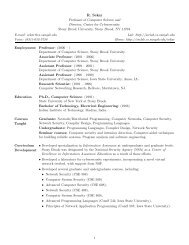SELF: a Transparent Security Extension for ELF Binaries
SELF: a Transparent Security Extension for ELF Binaries
SELF: a Transparent Security Extension for ELF Binaries
You also want an ePaper? Increase the reach of your titles
YUMPU automatically turns print PDFs into web optimized ePapers that Google loves.
¡¡¡infrastructure so that it is easily adaptable by existing compilerdevelopers.The standard we propose in this paper is a first-step towards achievingthese objectives.2. RELATED WORKThere has also been a significant amount of work done in the areaof tools to support binary editing. Of these, QPT [25], alto [29]and OM [42] and EEL [24] target RISC architectures. PLTO [12],and LEEL [46] target x86 <strong>ELF</strong> binaries. For the Windows environment,Etch [36] is a tool that targets x86 binaries and Vulcan [13]works with x86, IA64 and MSIL binaries. Dyninst [4] supportsanalysis and instrumentation of code at runtime. UQBT [8] is anarchitecture-independent binary translation framework. Un<strong>for</strong>tunately,none of these tools can distinguish code from data in allcases, so they are not guaranteed to work <strong>for</strong> every binary. Thislatter restriction applies to all the existing work, in particular <strong>for</strong>the x86 architecture, it is not possible to distinguish code from dataunless the compiler obeys certain code generation restrictions, orprovides some auxiliary in<strong>for</strong>mation.Typed Assembly Language (TAL) [27] adds type annotations andtyping rules to assembly language. While TAL is an extensive bodyof work that produces verifiably safe code, it is an entirely differenttarget plat<strong>for</strong>m, that requires whole scale rewriting of existing compilerinfrastructure. On the other hand, we target existing systemsand target plat<strong>for</strong>ms to trade-off between practicality and strongverifiable guarantees.There are also a number of other approaches to preventing low levelmemory related programming error exploits. Static analysis hasbeen used to detect memory errors at compile-time. Work in thisarea includes Splint [23, 15], CQual [41] and BOON [44]. Most ofthese techniques are limited by the availability of source code <strong>for</strong>the programs that are analyzed.In addition, static analysis and verification have been used to provesafety properties of programs. Proof carrying code [30], MOPS [6],and metacompilation [20] are all examples of techniques that ensureprogram properties through static analysis and verification.Most of these approaches depend on availability of source codeor using a type safe language. Model carrying code [40] could beused to verify program properties by generating models from binaries,but the accuracy of such models depends very much on theauxiliary in<strong>for</strong>mation that is provided along with <strong>S<strong>ELF</strong></strong>.Runtime checking uses inserted checks to detect memory errors be<strong>for</strong>ethey can be exploited. Work in this area <strong>for</strong> low level memorysafety includes bcc [9], Purify [21], Safe-C [2], CCured [31] andruntime type checking [26]. Also in this category is the CodeCenterinterpretive debugger [22]. These approaches all introduce highruntime overheads of at least 100%, making them useful <strong>for</strong> debuggingand testing, but not <strong>for</strong> incorporating into production binaryreleases.In addition, runtime monitoring <strong>for</strong> safety has been used to ensureaccess control, resource access and temporal safety properties.Java [19], Naccio [16], and SASI [14] are all examples of systemsthat per<strong>for</strong>m runtime checks. SASI operates on binaries and per<strong>for</strong>mscode trans<strong>for</strong>mation. However, as mentioned earlier, its successis largely dependent on the presence of invariants obeyed bythe code generation strategy of the gcc compiler. The modificationswe suggest to <strong>ELF</strong> would be beneficial to SASI and similartechniques, as they could leverage the in<strong>for</strong>mation in the extra sectionwhile per<strong>for</strong>ming the analysis <strong>for</strong> the trans<strong>for</strong>mation.3. <strong>S<strong>ELF</strong></strong> – AN ENHANCEMENT TO <strong>ELF</strong>In this section, we describe the enhancement to the <strong>ELF</strong> binaryfile <strong>for</strong>mat which will enable the analysis and trans<strong>for</strong>mation ofbinary code. The extension is simple; yet, it enables a wide rangeof sound program analyses to be per<strong>for</strong>med simply by addressingthe drawbacks that were presented in Section 1.Our discussion is centered around the <strong>ELF</strong> file <strong>for</strong>mat and we shallexclusively describe it in the context of the x86 architecture. However,the general principles behind this discussion are applicable toother <strong>for</strong>mats and architectures.Be<strong>for</strong>e describing our extension, we shall briefly describe the <strong>ELF</strong><strong>for</strong>mat. (See [32] <strong>for</strong> a detailed discussion.)3.1 <strong>ELF</strong> <strong>for</strong>mat<strong>ELF</strong> files fall into the following three types:Executable files containing code and data suitable <strong>for</strong> execution.This specifies the memory layout of the process imageof program.Relocatable (object) files containing code and data suitable<strong>for</strong> linking with other object files to create an executable or ashared object file.Shared object files (shared library) containing code and datasuitable <strong>for</strong> the link editor (ld) at the link-time and the dynamiclinker (ld.so) at runtime.A binary file typically contains various headers that describe theorganization of the file, and a number of sections which hold variousin<strong>for</strong>mation about the program such as instructions, data, readonly-data,symbol table, relocation tables and so on.Executable and shared object files (as shown in the execution viewof Figure 1) are used to build a process image during execution.These files must have a program header table, which is an array ofstructures, each describing a segment or other in<strong>for</strong>mation neededto prepare the program <strong>for</strong> execution. An object file segment containsone or more sections. Typically, a program has two segments:(1) a code segment comprised of sections such as .text (instructions)and .rodata (read-only data) (2) a data segment holdingsections such as .data (initialized data) and .bss (uninitializeddata). The code segment is mapped into virtual memory as a readonlyand executable segment so that multiple processes can use thecode. The data segment has both read and write permission and ismapped exclusively <strong>for</strong> each process into the address space of thatprocess.A relocatable file (as shown in the linking view of Figure 1) doesnot need a program header table as the file is not used <strong>for</strong> programexecution. A relocatable file has sufficient relocation in<strong>for</strong>mationin order to link with other similar relocatable files. Also, every relocatablefile must have a section header table containing in<strong>for</strong>mationabout the various sections in the file.





